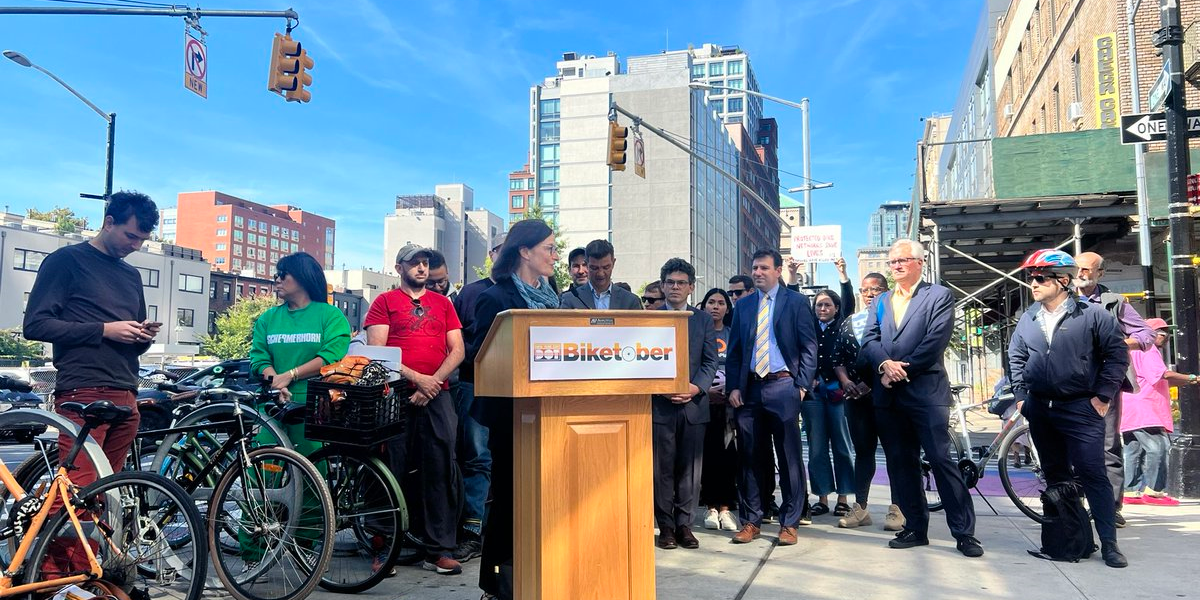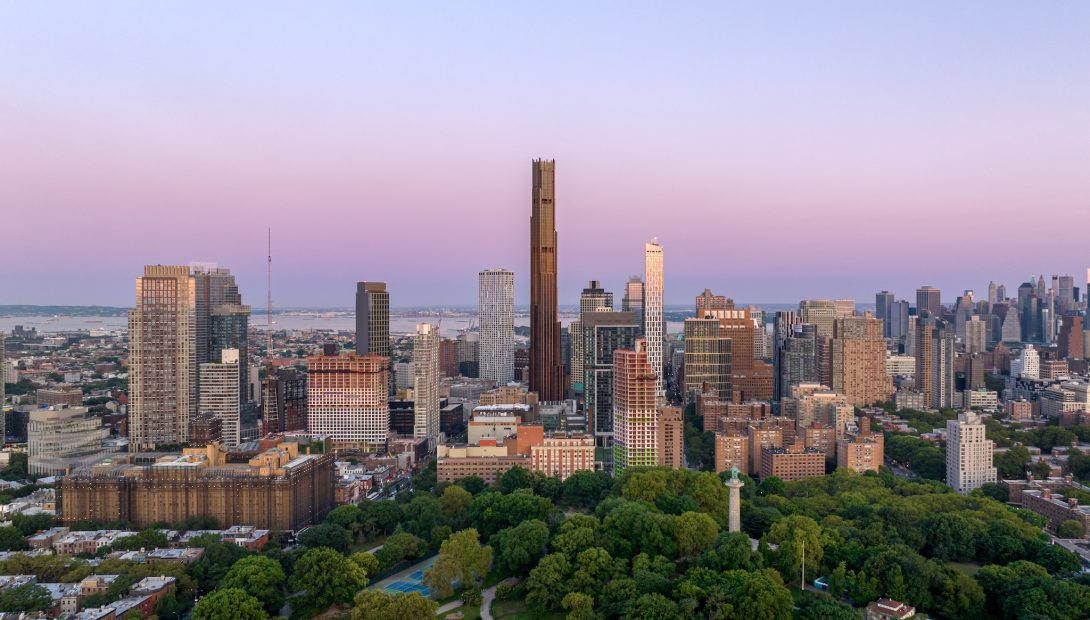The newly redesigned Schermerhorn Street delivers 1.2 miles of protected bike lanes and much needed traffic-calming to improve safety of all road users. Project complements nearby protected bike lanes and new network of car-light Shared Streets in Downtown Brooklyn, promoting safe and sustainable transportation.
Department of Transportation Commissioner Ydanis Rodriguez today celebrated the substantial completion of the Schermerhorn Street redesign in Downtown Brooklyn. This transformative project brings major safety improvements – including a two-way protected bike lane, one-way vehicle traffic, and new pedestrian space – to a crucial east/west bicycle route that connects cyclist to/from the Brooklyn and Manhattan Bridges. The new design also compliments a budding network of car-light Shared Streets in Downtown Brooklyn to create a people-focused business district.
“As our administration continues to add and protect bike lanes, we are not simply isolating one type of infrastructure — we are looking holistically at our streets and implementing comprehensive plans to make them safer,” said New York City Mayor Adams. “This Biketober, the cycling community can feel confident that this administration is prioritizing their safety and taking action with tools proven to keep cyclists, pedestrians, and all road users safer. We look forward to continuing to work with the community to identify opportunities for these kinds of redesigns.”
“Biketober is a reminder that cycling is a sustainable, healthy, and just fun way to get around. It is especially meaningful to celebrate this Biketober at Schermerhorn Street, where we have delivered a transformative safety project that has completely changed the look and feel of the corridor with new bike and pedestrian spaces,” said Commissioner Rodriguez. “We are working every day to support safe, sustainable, and efficient transportation options – that includes aggressively building new bike lanes while upgrading existing routes.”
“The NYPD knows that traffic safety is public safety and embraces the array of traffic innovations being announced today to improve the safe movement of pedestrians, cyclists and all of the city’s road users,” said NYPD Chief of Transportation Kim Y. Royster. “The redesigning of these areas in Brooklyn are in line with the NYPD’s mission of keeping New Yorkers and the streets they travel on as safe as possible.”
“Health and wellness come in many forms, including staying active and making use of transportation alternatives to cars or other vehicles,” said Health Commissioner Dr. Ashwin Vasan. “I find joy in getting around town on a bicycle. That promotes more than just physical health, it also supports my mental wellbeing. As a city, physical activity is something we must encourage and there is no greater invitation to ride than a safe, protected bike lane for New Yorkers to enjoy.”
More than 1,000 cyclists ride along Schermerhorn Street on a typical weekday. DOT’s redesign better accommodates riders by implementing a one-way conversion for vehicle traffic on Schermerhorn, between Smith St and Flatbush Avenue, to create room for a 10-foot, two-way bike lane on the south side of the street. The project also delivered new pedestrian space at intersections to slow down turning drivers and shorten the time pedestrians spend crossing traffic. The redesign provides a more comfortable and safer bike link between the East River bridges to South Brooklyn and downtown Manhattan and compliments the existing nearby protected bicycle lane network, including the popular new Brooklyn Bridge bike lane.
This holistic redesign improves traffic safety for all road users. Protected bike lanes have proven to reduce traffic deaths and serious injuries by 18%. The addition of pedestrian islands has shown to drop serious injuries and fatalities by 35.5%.
DOWNTOWN BROOKLYN SHARED STREET NETWORK
Working in close collaboration with the Downtown Brooklyn Partnership, the DOT is currently installing a network of Shared Streets within Downtown Brooklyn to support a pedestrian-centric business district. Shared Streets deploy unique street designs that naturally slow traffic and prioritize pedestrians and cyclists while still allowing for local vehicle access for deliveries and pick-ups or drop-offs. This neighborhood network better allocates streets for the majority of its users – pedestrians – to create more welcoming, vibrant public spaces and strengthen the local economy.
This plan builds on several existing Shared Streets on Willoughby and Pearl streets as well as the DOT’s Broadway Vision project to center pedestrians and cyclists along. Under the NYC Streets Plan, DOT will continue exploring the implementation of similar Share Street networks elsewhere. Shared Streets identified for Downtown Brooklyn include:
- Hoyt Street, Fulton and Schermerhorn streets (under implementation)
- Elm Place, Livingston to Fulton streets (under implementation)
- Bridge Street (under implementation)
- Willoughby Avenue expansion (proposed)
- Pearl Street expansion (proposed
- Lawrence Street (proposed)
- Fleet Street (proposed)
- Bond Street (proposed)
BIKETOBER EVENTS
DOT is also celebrating Biketober with a series of events to encourage safe cycling. Our Bike the Block program features a series of open-street events focused on bicycle programming, education, rides, and resources. The DOT is organizing street closures within underserved communities, offering programming that promotes fun, sustainable, healthy activities. The events will feature tips for riding, bike repair, bike law education, group bike rides, giveaways and cultural programming. The goal with these events is to expand DOT’s outreach and engagement around Street Improvement Projects, empower communities to reimagine their streets, create a platform for local cycling advocacy, and address barriers to biking. Our Safety Education team will provide free helmet fittings in cooperation with several local Councilmembers and will staff pop-up light and bell giveaways. For more information visit nyc.gov/biketober.
“Schermerhorn Street had been the worst bike lane in Brooklyn for years. Now, we finally have the two way protected bike lane that our community has demanded and that will allow New Yorkers to cycle through Downtown Brooklyn safely and efficiently,” said Lincoln Restler, City Council member. “Thank you to DOT and all the neighbors and advocates who helped us achieve this campaign priority in our first year in office.”
“The Schermerhorn Street bike lane is a long-awaited and welcome improvement to Downtown Brooklyn’s transportation network,” said Regina Myer, president of Downtown Brooklyn Partnership. “These changes build upon our recently expanded Shared Street network and the recommendations put forward in DBP’s Public Realm Action Plan, which seek to create a more bike- and pedestrian-friendly downtown, and create safer connections to and from Manhattan. Thanks go to NYCDOT for implementing this important work, and we look forward to more to come!”
“The Schermerhorn Street redesign is a monumental improvement in safety for local bike riders and pedestrians,” said Ken Podziba, President and CEO of Bike New York. “For too long, this area of Brooklyn has been a major site of placard abuse and unsafe driving. We thank DOT Commissioner Rodriguez and his staff for their leadership in tackling this crucial connection point in Brooklyn, and we look forward to seeing similar safe and connected bike infrastructure as part of DOT’s ongoing vision for the city.”
“Residents in neighborhoods with wide streets that aren’t quite suitable for two lanes of car traffic – like much of BedStuy – should look to the new Schemerhorn bike lane as an example that streets can be reconfigured to accommodating to their bike commuting children and neighbors without losing parking, and making cyclists more visible to all pedestrians,” said Courtney Williams, NYC People’s Bike Mayor at The Brown Bike Girl.
“Any time a dangerous street is redesigned to include safer spaces for pedestrians, bike riders, and other vulnerable people on our roads, that’s a good thing,” said Amy Cohen, co-founder of Families for Safe Streets. “We thank Mayor Adams and Commissioner Rodriguez for their work making the Schemerhorn redesign a reality. No death is acceptable on our streets, and we must scale these redesigns citywide.”

